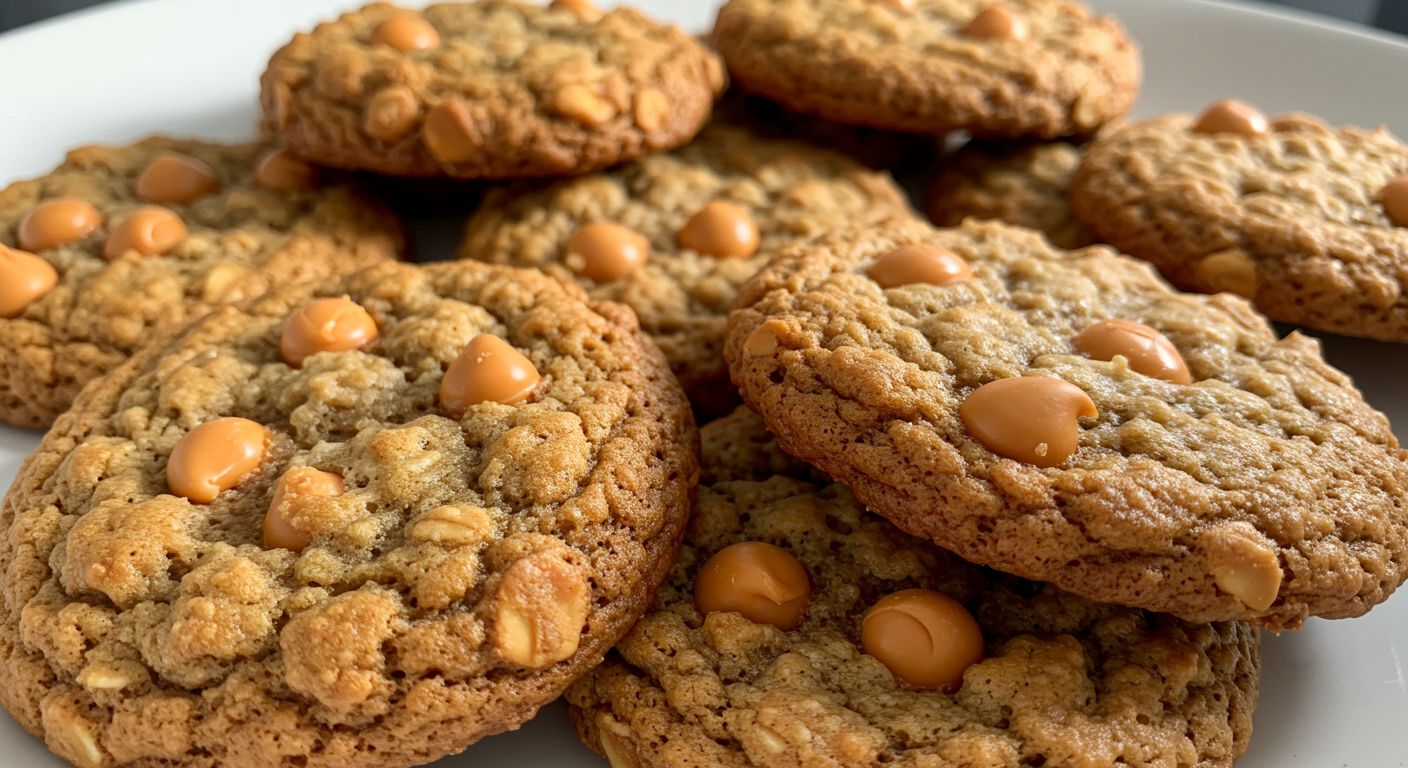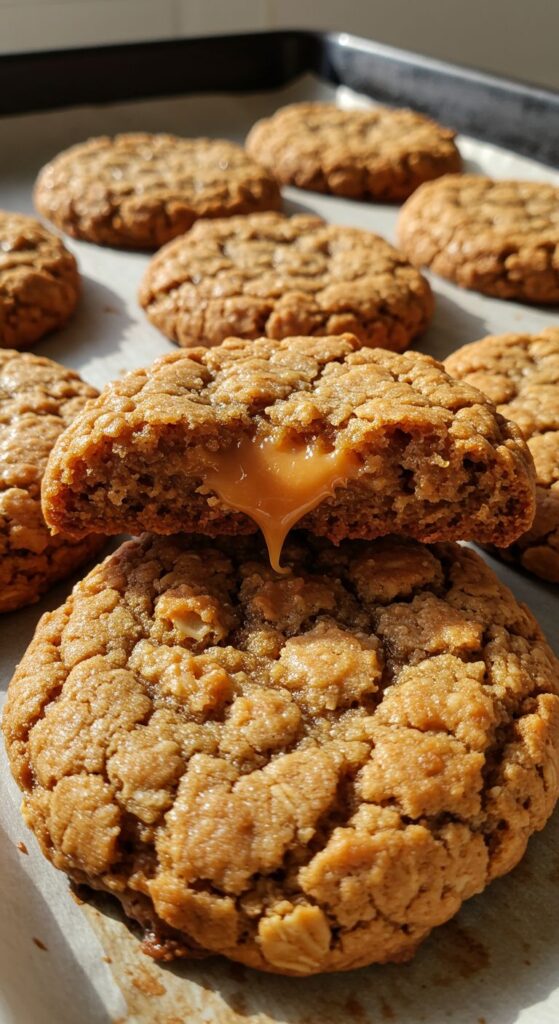
Table of Contents
When I smell these oatmeal butterscotch cookies baking, I go back to my grandma’s kitchen. The smell of butterscotch and oats is like a warm hug. These cookies are more than treats; they’re memories in every bite.
Making these cookies is like creating art. I’ve worked hard to get the recipe just right. It’s perfect for both new and experienced bakers. This recipe will make your cookies a hit with your family.
Key Takeaways
- Learn the secrets to perfect oatmeal butterscotch cookies
- Discover a foolproof recipe for soft, chewy texture
- Understand how to balance butterscotch and oatmeal flavors
- Master baking techniques for consistent results
- Create a nostalgic homemade snack that everyone will love
Why These Oatmeal Butterscotch Cookies Are Irresistible
Oat-based treats are special to me, like these oatmeal butterscotch cookies. They’re not just a dessert. They’re a trip back to old-fashioned favorites.
Classic Nostalgic Appeal
The butterscotch flavor brings back childhood memories. It’s like biting into a cookie from your grandmother’s kitchen. It’s warm, comforting, and full of love.
Perfect Texture Combination
The cookies have a great texture. They’re crispy on the outside and chewy inside. This mix is amazing and makes you want more.
Butterscotch and Oatmeal Harmony
Butterscotch and oatmeal together are magic. They make a flavor that’s both familiar and exciting.
- Rich butterscotch chips
- Hearty rolled oats
- Warm, comforting spices
| Ingredient | Quantity |
|---|---|
| Butterscotch Chips | 2 cups (320g) |
| Old-Fashioned Rolled Oats | 3 cups (297g) |
| Unsalted Butter | 3/4 cup (170g) |
These cookies are more than dessert. They’re a celebration of flavor, texture, and memories.
Essential Ingredients for Perfect Oatmeal Scotchies
Making yummy baked goods starts with picking the right ingredients. My oatmeal butterscotch cookies need special parts to make them special.
Let’s look at the main ingredients that make these cookies so good:
- Flour Foundation: 1 1/4 cups of all-purpose flour gives them shape
- Flavor Enhancers: 1/2 teaspoon each of cinnamon and salt add taste
- Binding Agents: 2 large eggs at room temperature hold it all together
- Sweetness Boosters: 1 cup dark brown sugar and 1/2 cup granulated sugar make them sweet
The key ingredients are old-fashioned rolled oats and butterscotch morsels. Choose thick-cut oats for the best texture. The butterscotch chips add a sweet caramel taste.
Pro tip: Use room temperature butter (1 cup) for smooth cookies. Add 1 teaspoon of vanilla extract for extra flavor.
Baking is a science of precision and passion – each ingredient plays a key role in making the perfect cookie!
The Science Behind Soft and Chewy Texture
Making the perfect oatmeal butterscotch cookie is an art. It mixes cooking science with baking skills. Knowing the chemistry of cookie texture can make your baking amazing.
Let’s explore the world of cookie chemistry. We’ll look at what makes cookies chewy and soft.
Brown Sugar’s Magic Touch
Brown sugar is key for a chewy texture. It adds moisture and flavor to cookies. This makes the cookies taste richer and more complex.
- Contains 3-5% more moisture than white sugar
- Contributes to a deeper caramel-like flavor
- Helps cookies rise up to 20% higher
Butter’s Critical Role
The butter’s temperature is very important. Using room temperature butter is best for chewy cookies. Cold or warm butter can change how cookies look and feel.
- Soft butter leads to more cookie spread
- Creaming butter incorporates up to 30% more air
- Impacts overall cookie volume and texture
Oat Selection Matters
Not all oats are the same for baking. The type of oats affects cookie texture. Old-fashioned oats are usually the best choice.
- Old-fashioned oats create better texture
- Provide more substantial bite
- Contribute to overall cookie integrity
Learning these scientific tips helps make oatmeal butterscotch cookies that are always delicious and chewy.
Step-by-Step Mixing Method
Making yummy homemade snacks like oatmeal butterscotch cookies needs a special mixing way. I’ll show you how to mix them perfectly so they taste amazing.
First, get your ingredients ready. Mix dry and wet things apart before combining them. Precision is key in baking!
- Whisk flour, cinnamon, baking soda, and salt in a medium bowl
- In a big bowl, mix softened butter with brown and granulated sugars
- Beat in eggs one at a time, then add vanilla extract
- Mix dry ingredients into the wet mix slowly
- Fold in oats and butterscotch chips gently
The secret to great homemade snacks is not mixing too much. Just mix until everything is together. This makes your cookies soft and not hard.
Pro tip: Chill the dough for at least 45 minutes before baking for the best results!
My mixing way makes sure your oatmeal butterscotch cookies are perfect every time. You can make them in just 15 minutes. They’re a quick and tasty treat.
Tips for Achieving the Perfect Cookie Shape
Making beautiful oatmeal butterscotch cookies is more than mixing. The shape and look of your cookies matter a lot. I’ll share tips to help you make cookies that look as good as they taste.
Proper Dough Portioning
It’s important to have cookies of the same size for even baking. Use a cookie scoop to make sure each cookie is the right size. A 2-tablespoon scoop is perfect for these cookies.
- Use a uniform cookie scoop for consistent sizing
- Aim for approximately 3 tablespoons of dough per cookie
- Level the scoop for precise measurement
Spacing Guidelines
Space cookies right to stop them from sticking together when baked. Place them at least 4 inches apart on baking sheets.
| Baking Sheet Size | Maximum Cookies per Sheet | Recommended Spacing |
|---|---|---|
| Half Sheet Pan | 12 cookies | 2-4 inches apart |
| Large Sheet Pan | 15-18 cookies | 2-4 inches apart |
Cookie Spreading Control
To control cookie spread, chill the dough first. This helps a lot. Also, use room temperature butter around 65 degrees Fahrenheit for the best shape.
Pro tip: If cookies spread too much, reshape them with a spatula right after they come out of the oven.
Baking Time and Temperature Guidelines
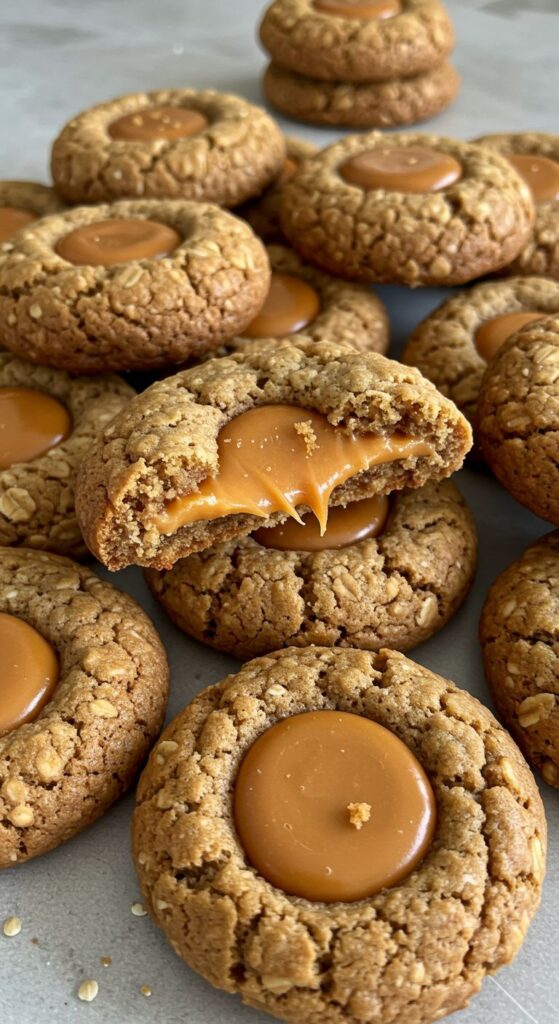
Making the best homemade snacks needs care, like baking oatmeal butterscotch cookies. I’ll show you how to get it right with baking time and temperature.
First, heat your oven to 350°F (177°C). This temperature makes your cookies bake evenly. Here are the key baking tips:
- Baking time: 10-12 minutes
- Cookie appearance: Lightly browned edges
- Center texture: Soft but set
Watch your cookies closely in the last few minutes. They might look a bit soft in the middle. But they’ll cook more after you take them out. This keeps them chewy.
Pro tip: Turn your baking sheet halfway through. This ensures even browning. Ovens can vary, so watch your first batch closely.
Want different textures? Change your baking time:
- Chewy cookies: 7-8 minutes
- Crisp cookies: 9-10 minutes
The secret to great baked goods is knowing your oven and watching for signs. Let cookies cool on the sheet for 5 minutes. Then move them to a wire rack to set.
Storage and Freshness Tips
Keeping homemade snacks like oatmeal butterscotch cookies fresh is key. I’ll share tips to keep your treats tasty and fresh for longer.
Room Temperature Storage Strategies
To keep your cookies just right, follow these steps:
- Store cookies in an airtight container
- Keep at room temperature for up to 5 days
- Place a sheet of parchment paper between cookie layers
- Avoid humid or direct sunlight areas
Freezing Methods for Long-Term Preservation
Freezing is great for keeping snacks fresh longer. Pro tip: Freeze both baked cookies and raw dough easily.
| Cookie Type | Freezing Duration | Storage Recommendation |
|---|---|---|
| Baked Cookies | Up to 2 months | Wrap individually in plastic wrap |
| Cookie Dough | Up to 2 months | Store in freezer-safe container |
Perfect Thawing Techniques
Thawing frozen cookies is easy:
- Remove cookies from freezer
- Let them sit at room temperature for 15-30 minutes
- For crisp texture, warm in oven at 300°F for 3-5 minutes
Freezing doesn’t compromise taste – your cookies will remain as delicious as the day they were baked!
Common Baking Mistakes to Avoid
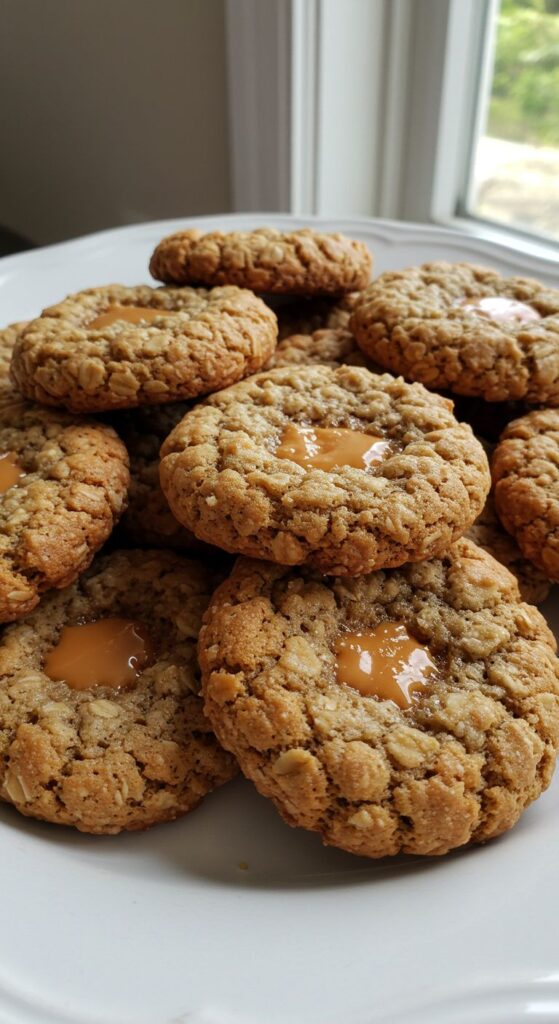
Even skilled bakers can make mistakes when baking. Knowing these errors can make your treats amazing.
Getting the temperature right is key for perfect cookies. Butter temperature is very important. Softened butter, about 30 minutes at room temperature, is best. Cold butter makes cookies thick and dense. Too warm butter makes them spread too much.
- Incorrect butter temperature can ruin cookie texture
- Precise ingredient measurements are essential
- Oven calibration impacts baking results
Measuring ingredients correctly is also vital. A kitchen scale gives the most accurate readings. Too much flour makes cookies dry and crumbly. Too little flour makes them flat and greasy.
Baking soda and salt are often forgotten but are very important. Too little baking soda makes cookies flat and lumpy. Forgetting salt makes them too sweet. It’s all about finding the right balance.
- Use unsalted butter to control salt content
- Cream sugar and butter for approximately 2 minutes
- Space cookies 1 inch apart on baking sheets
The quality of your oven and baking sheet matters a lot. A good baking sheet helps cookies bake evenly. Preheat your oven to 375 degrees Fahrenheit for the best results.
Creative Variations and Add-ins
Try new things to make your oatmeal butterscotch cookies even better. You can turn them into exciting desserts that everyone will love. I’ve found great ways to make this favorite treat even more special.
Here are some cool mix-ins to make your oat treats better:
- White chocolate chips with toasted macadamia nuts
- Dark chocolate chips and dried cranberries
- Raisins and cinnamon
- Chopped pecans and caramel chips
Here are some tips for adding new things to your cookies:
- Keep the same amount of the original recipe
- Make big pieces small
- Find the right mix of sweet and nutty
- Don’t add more than 1 cup of extra stuff
| Variation | Flavor Profile | Recommended Add-ins |
|---|---|---|
| Tropical Twist | Sweet and Nutty | Macadamia nuts, white chocolate |
| Chocolate Lover’s | Rich and Decadent | Dark chocolate chips, cocoa powder |
| Fruit Fusion | Tangy and Sweet | Dried cranberries, orange zest |
Pro tip: Always test new combinations in small batches to perfect your unique dessert recipes!
“Baking is about passion, creativity, and never being afraid to experiment.” – Anonymous Baker
Pairing Suggestions and Serving Ideas
My oatmeal butterscotch cookies are great for many occasions. They make any moment special with the right pairings and how you present them.
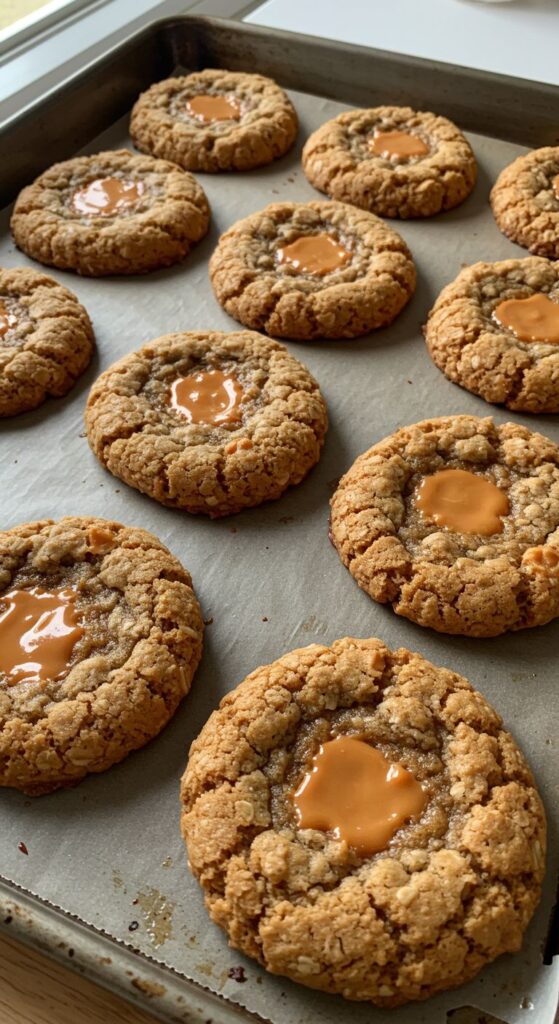
Beverage Pairings
- Hot black coffee
- Cold milk
- Chai tea
- Hot chocolate
Dessert Companion Ideas
- Vanilla bean ice cream
- Greek yogurt parfait
- Whipped cream
- Caramel drizzle
For parties, set up a cookie platter. Use a rustic wooden board and add things that go well with the cookies. The butterscotch chips add a sweet touch that’s perfect with creamy or tangy things.
Creative Serving Suggestions
- Cookie ice cream sandwiches
- Crumbled cookie topping for puddings
- Gift packaging for homemade snacks
- Dessert charcuterie board centerpiece
Pro tip: Warm the cookies a bit before serving. It makes their butterscotch smell better and keeps them soft. Your guests will love these treats!
Conclusion
I’ve shared how to make yummy oatmeal butterscotch cookies. These cookies are more than a recipe. They connect us to old baking traditions that make our kitchens warm and joyful.
Making these cookies takes patience and care. You can make 16 to 18 cookies in just 40 minutes. It’s all about getting the right mix of ingredients and techniques.
Baking is like art, and it gets better with practice. If your first batch doesn’t turn out right, don’t worry. Every time you bake, you’ll get better. The most important thing is the love you put into making these treats.
I hope this guide made you want to bake and make special memories. So, get your oven ready, gather your ingredients, and start baking!
FAQ
What’s the difference between old-fashioned rolled oats and quick oats?
Old-fashioned rolled oats are less processed. They give cookies more texture. They keep their shape better and make cookies chewier.
Quick oats are finer and make cookies softer. For the best cookies, use old-fashioned rolled oats.
Can I substitute butterscotch chips with another type of baking chip?
Yes! You can try chocolate chips, white chocolate chips, or caramel chips. Each adds a different flavor. Remember, the taste will change with the chip you pick.
How do I prevent my cookies from spreading too much during baking?
To stop cookies from spreading too much, chill the dough for 30 minutes. Use room temperature butter, not melted. Make sure your baking sheet isn’t too hot.
Using a silicone mat or parchment paper helps too.
How long can I store oatmeal butterscotch cookies?
Store them in an airtight container at room temperature for 5-7 days. Freeze them for up to 3 months. Use parchment paper between layers to prevent sticking.
Are oatmeal butterscotch cookies considered a healthy treat?
These cookies have oats, which are good for you. But they’re also sweet with sugar and butter. Enjoy them in moderation as part of a balanced diet.
Can I make the cookie dough ahead of time?
Yes! You can make dough ahead and store it in the fridge for 3 days or freeze for 3 months. Let it sit at room temperature for 15 minutes before baking.
What’s the best way to get a chewy texture in these cookies?
Use brown sugar for moisture. Don’t overbake. Take them out when edges are set but centers look a bit underbaked. They’ll set as they cool.
Can I make these cookies gluten-free?
Yes, use gluten-free flour and gluten-free oats. The texture might be different, but they’ll be gluten-free.

